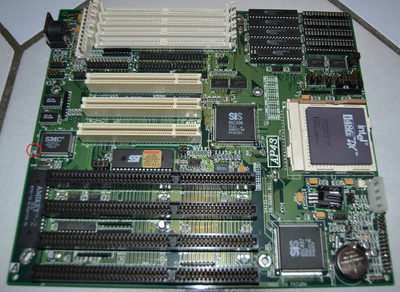First post, by j'ordos
Hi,
I have an Acer AP43 486 mobo that is not working with it's optimal BIOS settings. I did some testing, and narrowed it down to the setting in the title.
When I set CPU to PCI post write buffer to enabled the system freezes after (?) POST, showing a garbled screen (using a PCI graphics card), the floppy light remains lit and the keyboard is non-functional - I have to reset.
When the setting is disabled it boots fine.
Interesting to note: when I got the board it was broken - it wouldn't even start. I eventually noticed that one of the SMD capacitors was missing. I just replaced it with whatever I had lying around (a 100pF one I think), since I couldn't find out what the original value was. 😀
(near the UMC chip, inside the red circle 😀 )
Do you think that's the probable cause? Maybe someone with this board can check what the cap should be?
Thanks!
edit: note, this is not my board in the image, it's just for reference
